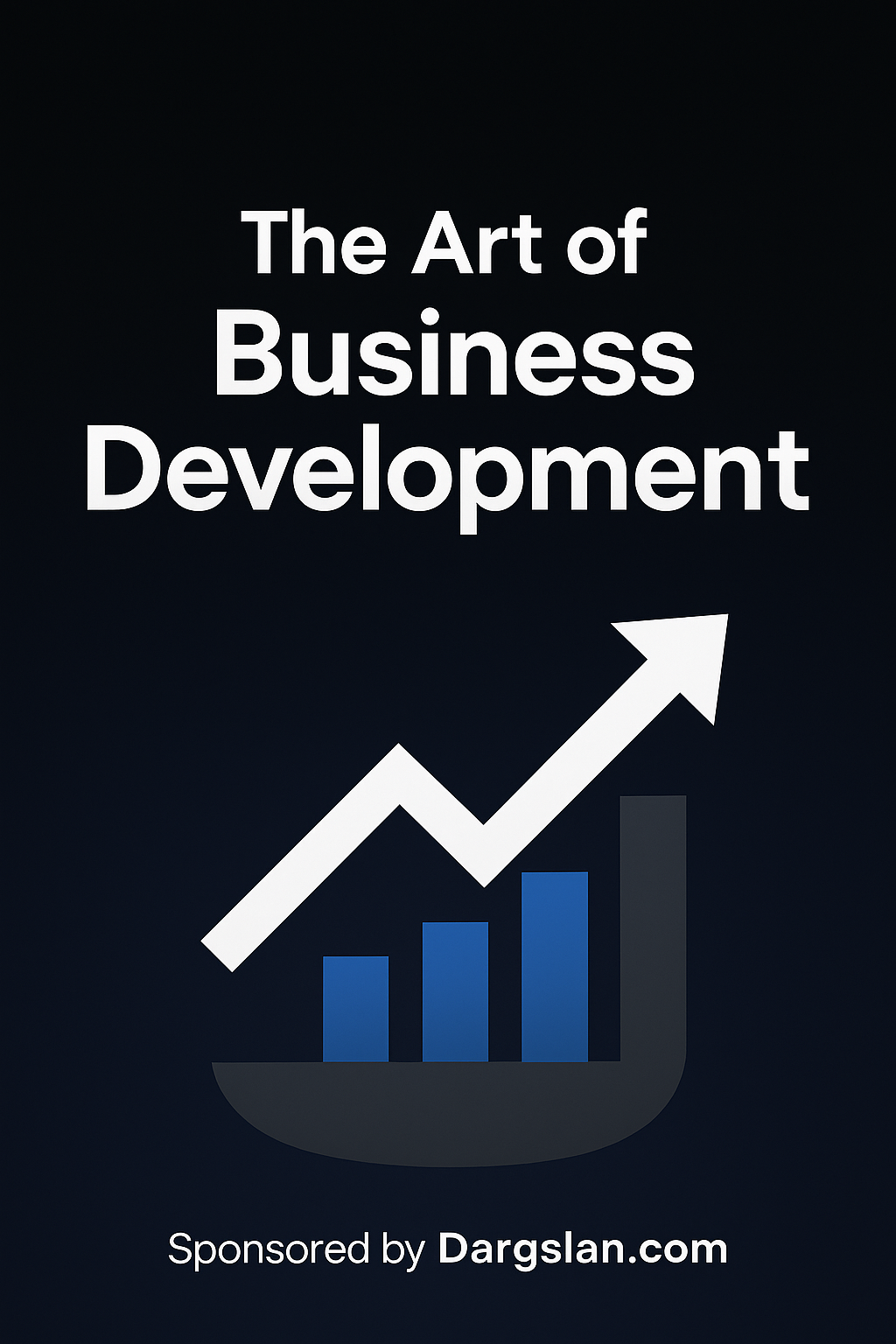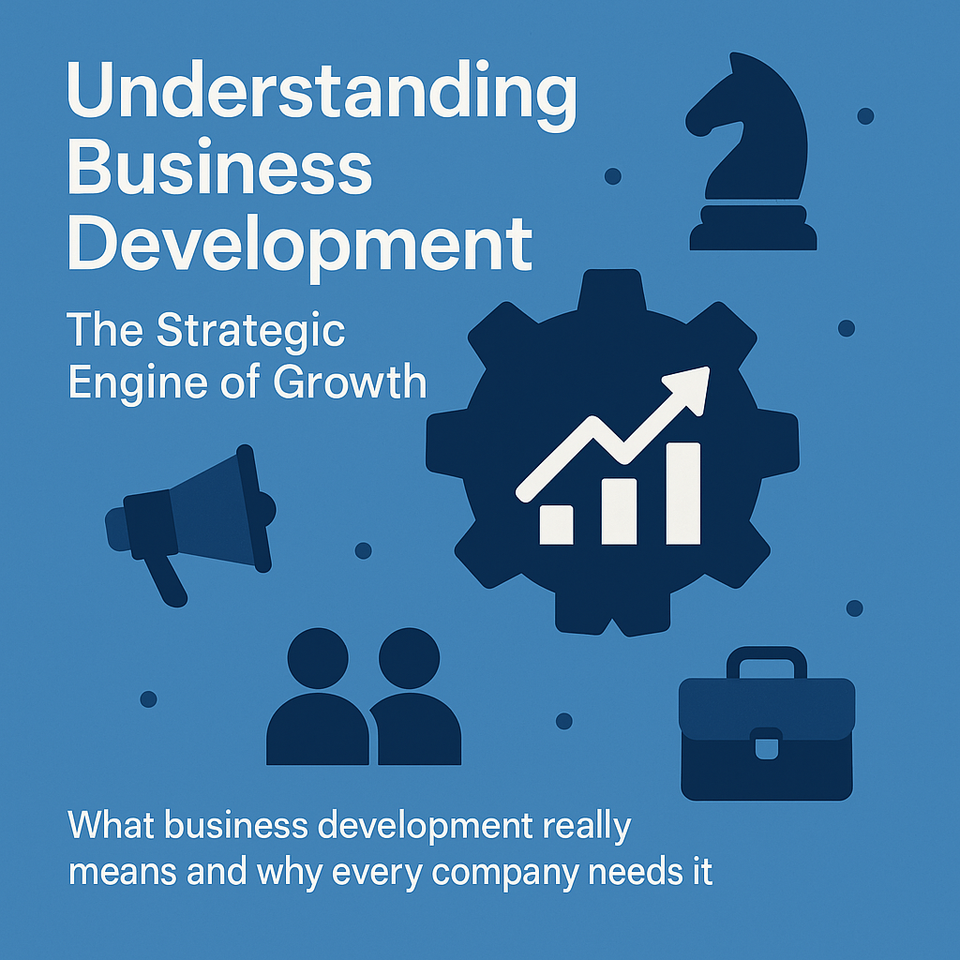The Art of Business Development: Building Growth That Lasts
Business development isn’t about chasing opportunities — it’s about creating them. Learn how strategy, systems, and trust build long-term growth in the digital era. Sponsored by Dargslan.com.

Sponsored by Dargslan.com — Building smarter digital systems for modern creators.
🚀 Introduction: Beyond Sales and Networking
Business development is not just about selling, networking, or chasing leads.
It’s about creating opportunities where none existed before — connecting ideas, people, and timing into something that drives long-term value.
True business development is quiet work: it happens behind the scenes, in strategic decisions, partnerships, and conversations that shape the direction of entire companies.
In this article, we’ll explore how modern business development works — the systems, the mindset, and the structure behind sustainable growth.
🧠 1. What Business Development Really Means
Most people confuse business development with sales.
Sales close deals.
Business development creates the environment where deals can happen.
It’s about building trust, aligning incentives, and seeing connections that others don’t.
At its core, business development is three things:
- Strategic Insight – understanding where the market is moving.
- Relationship Architecture – building bridges, not pipelines.
- Execution Discipline – transforming ideas into measurable outcomes.
This is not a department — it’s a mindset.
🔍 2. The Mindset of a Business Developer
The best business developers share one thing in common:
They think in systems, not transactions.
They understand that one partnership can open five others, that one good decision compounds over time, and that growth comes from focus, not from chasing everything.
🧩 Core Principles:
- Curiosity: Always ask “Why now?” and “Why this partner?”
- Empathy: Understand what success looks like for the other side.
- Clarity: Remove friction from decision-making — both internally and externally.
- Consistency: Keep showing up when others stop.
⚙️ 3. Strategy: The Foundation of Sustainable Growth
A good business development strategy answers three questions:
- Who do we want to work with?
→ Not everyone is the right partner. Define your ideal collaboration profile. - What value can we exchange?
→ Great deals are built on mutual leverage, not persuasion. - How do we measure success?
→ Revenue is one metric — but brand visibility, access, and data are often just as valuable.
💡 Pro tip:
The strongest deals happen when both sides feel they got the better end.
💬 4. Relationships: The Real Engine of Business Development
Business development is 80% relationships — but not in the way people think.
It’s not about collecting contacts; it’s about building credibility.
Credibility compounds when you:
- Keep your word.
- Follow up without pressure.
- Create value before asking for anything.
Every conversation is an investment.
Even if it doesn’t turn into a deal today, it plants a seed for tomorrow.
“People do business with those they trust, not those who pitch the hardest.”
🔧 5. Systems Thinking in Business Development
What separates amateurs from professionals is system design.
Professionals build pipelines that feed themselves.
They track communication, automate follow-ups, and build feedback loops.
A good BD system includes:
- A CRM for visibility (Zoho, HubSpot, or Notion setup)
- A knowledge base for lessons learned
- A dashboard for tracking engagement and response rates
- Templates and processes for outreach and partnership follow-up
When your system runs smoothly, you’re not chasing growth — you’re managing it.
📊 6. From Deals to Ecosystems
The future of business development isn’t just deals — it’s ecosystems.
The most successful companies build partnership webs, not linear pipelines.
They connect suppliers, creators, affiliates, and even competitors into systems that feed mutual growth.
For example:
- A SaaS tool partners with education creators to reach users faster.
- A publishing brand collaborates with platform developers for exposure.
- A consultancy integrates with automation platforms for compounding value.
These connections multiply impact without multiplying costs.
🧱 7. Common Mistakes in Business Development
Even seasoned professionals fall into traps. The most common ones include:
- Confusing motion with progress.
→ Sending 100 emails isn’t strategy — it’s noise. - Ignoring follow-ups.
→ Deals don’t die from rejection. They die from silence. - Short-term focus.
→ Chasing instant wins kills future leverage. - No documentation.
→ A deal isn’t real until it’s written, tracked, and measured.
Success in BD comes from structure, not hustle.
💼 8. The Long Game: Building Compounding Trust
In business development, reputation is your currency.
Every deal, every call, every email adds to (or subtracts from) your credibility.
The best players don’t think in quarters — they think in decades.
Ask yourself:
- Who still trusts me five years from now?
- Which relationships still generate value next year?
- What systems keep working even when I’m not online?
The answers to these questions determine your true growth trajectory.
🔄 9. Business Development in the Digital Era
Modern BD happens across digital ecosystems —
from X (Twitter) to LinkedIn, from Slack groups to niche communities.
The fundamentals haven’t changed — people still buy from people.
But the reach, timing, and efficiency have evolved.
A strong online presence now amplifies your offline credibility.
Every post, article, or comment is a micro touchpoint that can spark opportunity.
Consistency, again, becomes your biggest asset.
🧠 10. How to Build a Personal BD System
You can apply business development thinking to your own career too.
Try this simple 5-step structure:
- Map your network. Who are your key contacts and where are the gaps?
- Segment opportunities. Classify by urgency and potential impact.
- Automate small actions. Schedule follow-ups, reminders, updates.
- Add value first. Always give before you ask.
- Review monthly. What worked? What felt forced?
This creates compounding momentum — the same principle successful founders use to scale.
⚡ 11. Business Development vs. Growth Hacking
Growth hacking is short-term optimization.
Business development is long-term value creation.
The difference is intent.
Growth hackers look for shortcuts.
BD professionals build infrastructure that lasts.
“A growth hack lasts a month.
A partnership can last a decade.”
🧩 12. Tools That Power Business Development
Here are some modern tools that make BD efficient and data-driven:
- CRM & Outreach: HubSpot, Zoho One, Apollo.io
- Automation: Make.com, Zapier, Airtable
- Networking: LinkedIn, X Communities, IndieHackers
- Analytics: Notion dashboards, Google Data Studio
- Contracts & Docs: PandaDoc, Notion templates, Google Workspace
Use tools to free your time for strategy, not tasks.
💬 13. The Future of Business Development
AI is reshaping how we identify, connect, and manage relationships.
But the human element will never disappear.
The future belongs to those who combine:
- Automation for scale
- Empathy for trust
- Strategy for direction
This triad is the next competitive advantage.
💡 14. Key Takeaways
✅ Business development is not about chasing — it’s about creating.
✅ Relationships are your real capital.
✅ Systems scale, people sustain.
✅ Clarity beats complexity.
✅ Trust compounds faster than any metric.
🏁 Conclusion: Build, Don’t Chase
Business development is not a sprint — it’s a design.
It’s about building a system that grows with you, one authentic connection at a time.
If you approach BD with patience, clarity, and discipline,
growth becomes inevitable — not accidental.
The best opportunities aren’t found.
They’re built.
🖋️ Written for Dargslan.com
Empowering digital creators and system builders to grow smarter, not harder.


